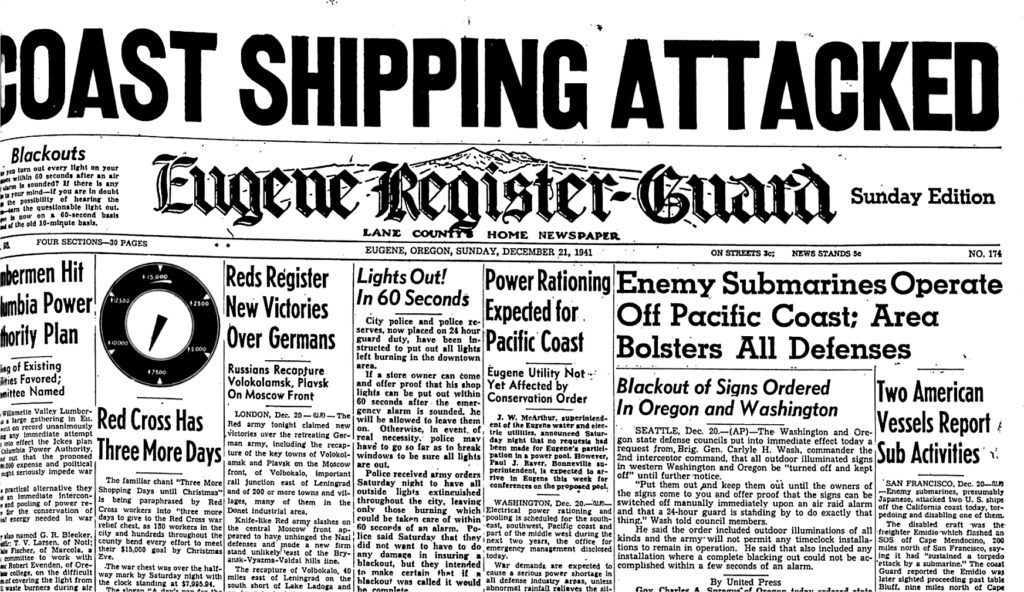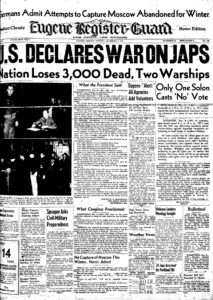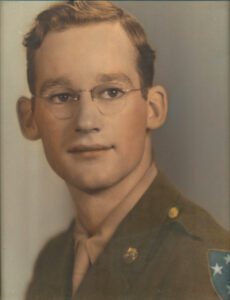Civic Stadium goes up; Lane County goes to war

1937-1947
By Mark Baker
For The Register-Guard
As the Depression began to fade in the late 1930s in Eugene and Lane County, there were signs of hope.
Eugene’s Civic Stadium was built, thanks to voters approving a levy to erect it and the federal Works Progress Administration created by President Franklin D. Roosevelt’s New Deal; and the Tall Firs, as the 1938-39 University of Oregon men’s basketball team was known, had a magical season, claiming the first-ever men’s NCAA basketball championship.
“Mighty Oregons Scramble Ohio State To Take Hoop Title of All America,” read the front-page headline in the March 28, 1939, Register-Guard.
Upon their return by train, the Tall Firs were greeted by “uncountable thousands” who lined Willamette Street, according to the March 31 story by Sports Editor Dick Strite. Eugene, after all, was on the cusp of going over 20,000 residents, according to the 1940 U.S. Census.
But war loomed, bringing a whole new set of challenges.

After two years of watching from afar after Germany’s invasion of Poland in September 1939, Eugene-Springfield, Lane County and all of Oregon and the West Coast would deal with a threat unlike any other in December 1941, after the Japanese bombing of Pearl Harbor on Dec. 7.
“U.S. Declares War on Japs,” read the banner headline on Dec. 8, using the politically incorrect vernacular of the day. “Nation loses 3,000 Dead, Two Warships.”
Another front-page headline that day was: “Eugene ‘Alert’; All Agencies Add Volunteers,” describing the anxiety and worry that Japan would next bomb the West Coast.
In a front-page box were “Blackout Rules.” Lane County was now in a “war zone,” and the daily blackout called for no lights between 12:30 a.m. and 7:30 a.m. All homes had to be dark, all cars’ headlights dimmed “and hooded with blue cellophane paper,” taillights off or covered.
There would be no bombs dropped on Oregon or anywhere else on the West Coast in December 1941, but they would come. Oregon was the only state on the U.S. mainland during World War II to be the target of Japanese bombings.
On Sept. 9, 1942, Japanese pilot Nobuo Fujita flew off a submarine deck and headed toward Brookings on the southern Oregon Coast, dropping two 168-pound incendiary bombs intended to start forest fires that would cause the U.S. Navy to retreat from the Pacific to protect the West Coast. But the bombs caused little damage, just small fires that were quickly extinguished.
Twenty years later, Fujita, who reportedly always felt great shame about his role in the war, was welcomed to Brookings and made an honorary citizen.
“Wide-Eyed Town Greets Wide-Eyed Pilot, Family,” read the front-page headline in the May 27, 1962, Register-Guard. The accompanying photo showed Fujita and his wife greeting the three young sons – Tom, Steve and Billy Jr. – of the McChesney family of Brookings. The family moved to Eugene soon after, where the McChesney brothers starred in track and field and cross country at South Eugene High School and the University of Oregon.
The only fatalities on the mainland during World War II occurred near Bly, a tiny community halfway between Lakeview and Klamath Falls, in the spring of 1945.
Elyse Mitchell, 26, a Sunday school teacher who was five months pregnant, and five children ages 11 to 14, were killed on May 5, 1945. Mitchell had tried to pick up a balloon bomb she found by the side of the road after getting out of her minister husband’s car on the way to a picnic with the children. The Japanese sent thousands of the bomb-carrying balloons across the Pacific in 1945 in another attempt to set Northwest forests afire.
With World War II in America’s and the world’s rear-view mirror and prosperous times upon the land, few in Lane County could have been more thankful that the most widespread war in world history was over than Alton Baker Sr.’s second-youngest son, Edwin Baker, better known to all as “Ted.” He had survived a harrowing three days hiding from Japanese armed forces in a South Pacific jungle during the Bougainville Campaign.

His body shredded and burned by at least two Japanese grenades, Pvt. Ted Baker, 20, was the only survivor of four men hunkered in a foxhole on March 10, 1944, and possibly the only man out of dozens to make it off Hill 260. His right arm permanently damaged, he was awarded the Purple Heart and the Bronze Star, making it home to his family in the fall of 1944 after being hospitalized for months.
Soon, he would join older brother Bunky, who started as a reporter in 1946, on the Register-Guard staff.
“I prayed,” Ted Baker, now 93 and the oldest living member of the Baker family, recalls. “Somebody had to be looking over my shoulder. I said, ‘If I ever get out of this mess, I’ll do anything I can to help other people. And I believe I did.”
As his father had before him, Ted Baker became a major Lane County philanthropist, helping raise millions for several organizations, including United Way of Lane County (originally called Community Chest when Alton Baker Sr. started it in the 1940s); the campaign to build Eugene’s Hult Center for the Performing Arts (it was Ted Baker who secured the key $3 million donation from retired lumberman Nils Hult); and the new Eugene Public Library that opened in 2002.
In the middle of the war came a significant local story, the opening of the new Eugene airport, Mahlon Sweet Field, on May 1, 1943, off Highway 99, just north of the Eugene city limits, as commercial airline service came to the area for the first time.
“Throng Gathers for Airport Ceremony; Air Service Begins,” read the front-page headline that day. The first flight to arrive was a United Airlines flight from San Francisco.
Mark Baker, who researched and wrote the stories for this special section, is a former Register-Guard reporter and a member of the third generation of the Baker family.

Mark Baker has been a journalist for the past 25 years. He’s currently the sports editor at The Jackson Hole News & Guide in Jackson, Wyo.
